Arcteryx Beta Ar Jacket Mens Medium Blue
From Arc'teryx's formidable hardshell lineup, the Beta AR slots in as the all-around workhorse. The jacket has been a flagship piece since its release back in 2000, and it's a favorite for everything from hiking and backpacking in rough conditions to mountaineering and ski touring. Arc'teryx updated the design last winter with Gore's latest Most Rugged Technology, a RECCO reflector, and small tweaks to the DropHood. But despite the changes, the Beta AR keeps the same combination of harsh-weather performance, well-tailored fit, complete feature set, and light weight that's made it our top-rated hardshell for a number of years. Below we outline our experiences with the Beta AR. To see how it stacks up to the competition, see our article on the best hardshell jackets.
Table of Contents
- Weather Protection
- Breathability
- Build Quality and Durability
- Weight and Packability
- Key Design Features
- Fit and Sizing
- Other Versions
- What We Like/What We Don't
- Comparison Table
- The Competition
Performance
Weather Protection
The Arc'teryx Beta AR has proven to be both a great shoulder-season and winter jacket, skillfully blocking out rain, wind, and snow. Built with the latest beefed-up version of Gore-Tex's Pro membrane, the jacket delivers bombproof 3-layer protection at a reasonable weight. Arc'teryx has cleverly divided this jacket into zones, with lighter-weight, more breathable 40-denier Gore-Tex Pro fabric used on the majority of the jacket and heftier 80-denier Gore-Tex Pro covering exposed (and wear-prone) areas such as the hood and shoulders. Compared with the burlier Alpha SV, which has a 100-denier Gore-Tex Pro build, the Beta AR is moderately less durable but hasn't given up much in terms of weather protection.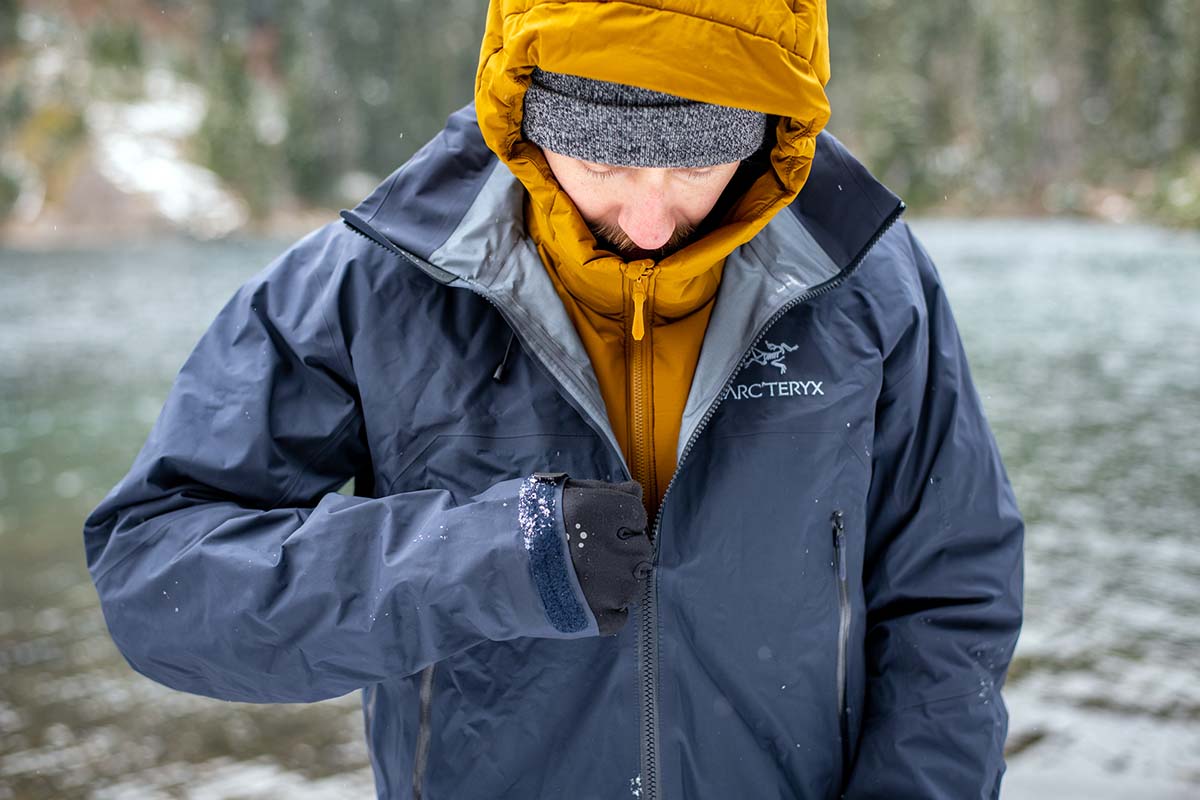
The Pacific Northwest is prime hardshell testing grounds, and we haven't found a vulnerability in the Beta AR's design yet. Like previous versions of the jacket, the high-quality DWR coating and fully taped seams have repelled downpours and snowfall that can wet out a lesser jacket. Additionally, Arc'teryx's WaterTight external zippers have helped to prevent moisture from penetrating the shell (Arc'teryx does state, however, that the zippers are not waterproof and only water-resistant). And to top it off, the AR features an adjustable, full-coverage hood with a separate collar that provides a cozy and warm seal around the neck. If I were to nitpick, the back length is a bit short to use as a dedicated ski shell, particularly on very deep days (more on this in "Fit and Sizing" below). But it's easy to get a solid seal with the dual adjustments at the hem, and we've found the protection otherwise is simply fantastic.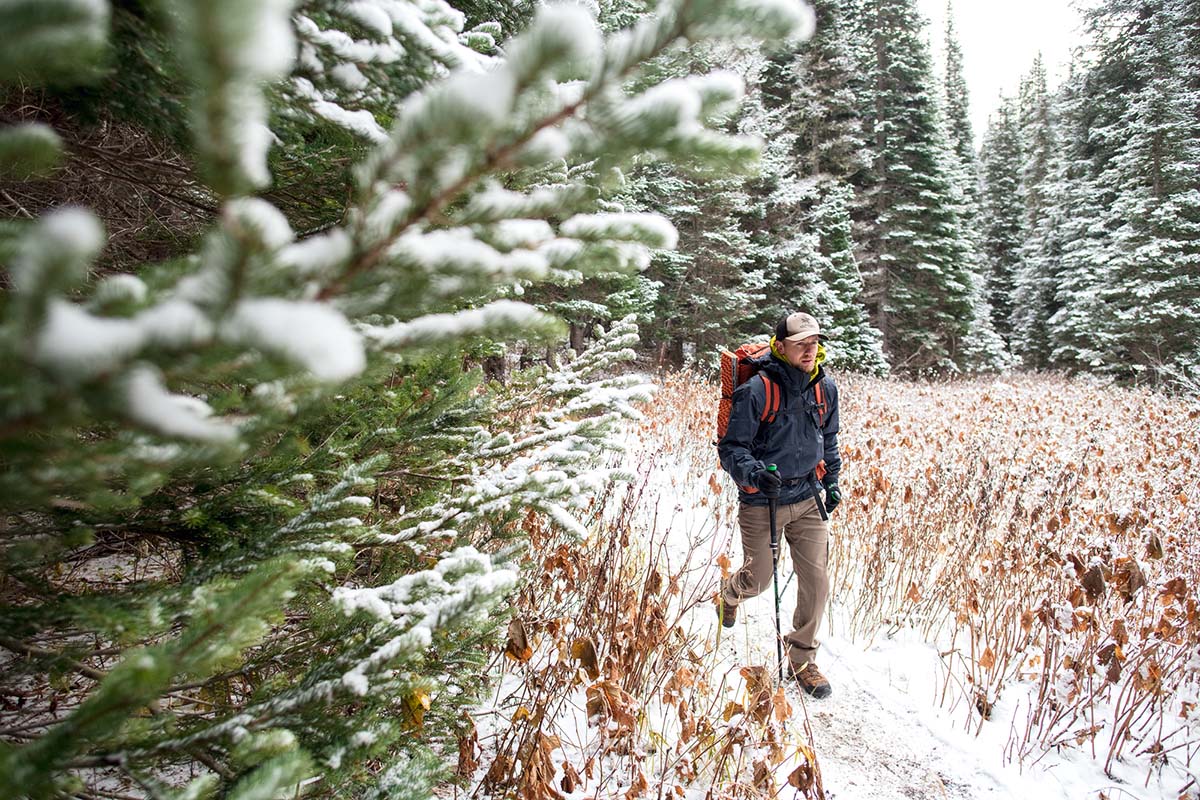
Breathability
One of the compromises in Gore-Tex Pro's standout weather protection is breathability, and the latest Most Rugged Technology hasn't moved the needle in this respect. To be fair, this is pretty common among serious hardshell jackets, but it does limit my primary uses with the Beta AR to transitions while backcountry skiing, on descents, and when the weather is particularly harsh. And for times when I've needed to wear the Beta on the move—such as a snowy alpine hike in Washington's Cascade Mountains—I often open up the pit zips to help regulate my temperature. The zips are reasonably large and easy to open and close with the large zipper pulls, and I've found they do their job in dumping heat. Overall, I would rate the Beta's breathability as middle-of-the-pack and it's perfectly serviceable for most cold-weather adventuring. That said, if you want a highly breathable shell and are willing to compromise some protection, there are better options out there (including Outdoor Research's AscentShell offerings).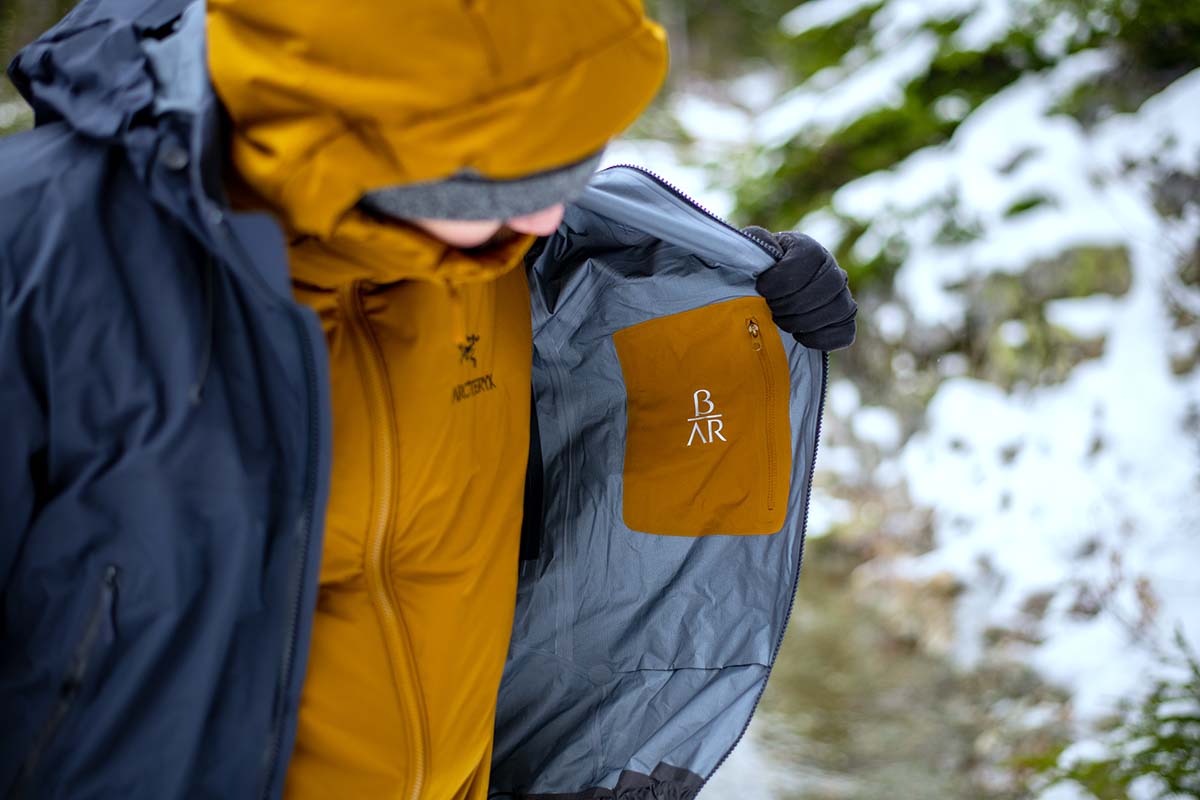
Build Quality and Durability
We have come to expect nothing less than top-notch quality from Arc'teryx, and the updated Beta AR is no exception. Every detail on this jacket has been attended to, from glove-friendly and confidence-inspiring zipper pulls and hood and hem adjustments, to clever fabric mapping and a precise 1.6-millimeter seam allowance. Generations of this jacket have withstood the elements, wear and tear, and hardships associated with life in the bottom of a pack with a shovel, probe, and ski crampons, and we have every reason to expect that to continue. As mentioned above, the high-use areas of the Arc'teryx Beta AR feature reinforced 80-denier Gore-Tex Pro with Most Rugged Technology (quite the mouthful to say), providing extra durability in the arms and shoulders and allowing the jacket to effectively resist abrasion from backpack straps. And we've found that the thinner 40-denier variation of the "Most Rugged" fabric doesn't sacrifice much durability either, with a surprisingly burly and confidence-inspiring feel.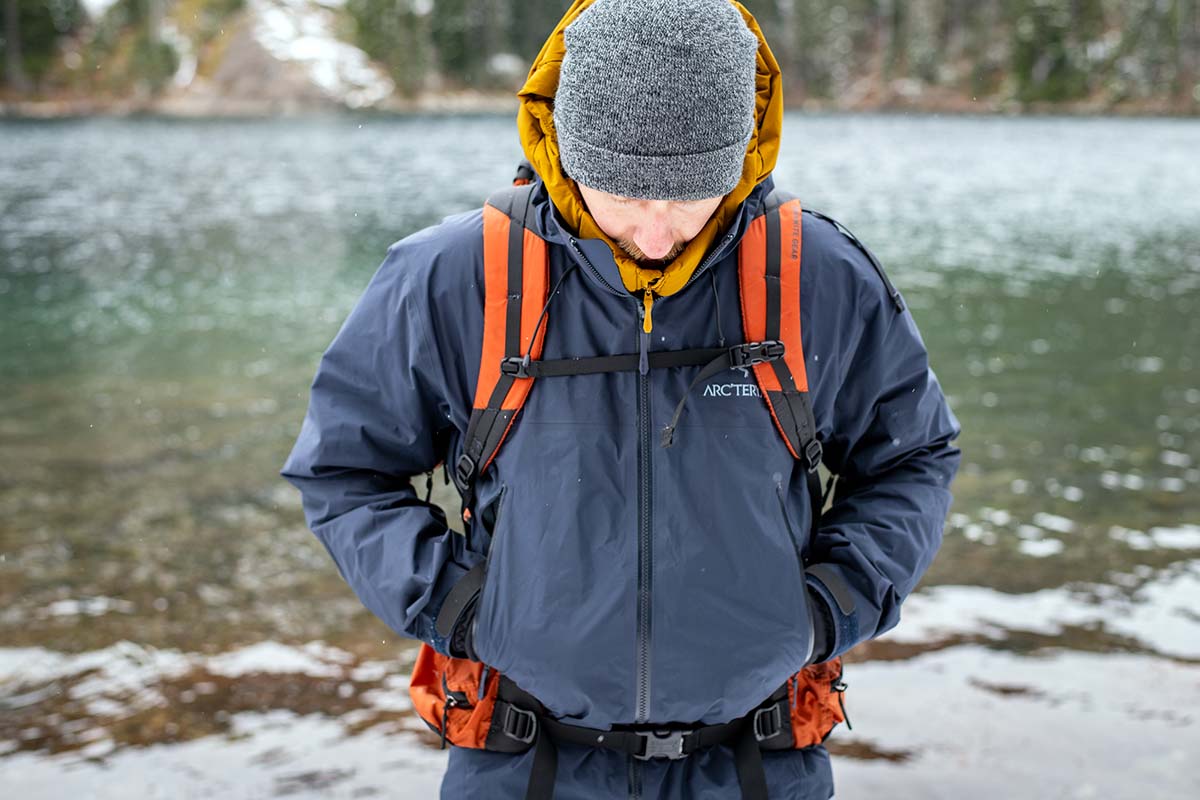
Weight and Packability
The Beta AR weighs in at 15.6 ounces for a men's medium (listed weight is 1 lb. even), which puts it about middle of the pack for alpine-ready hardshells. It's certainly not a fast-and-light machine like Arc'teryx's own Alpha SL Anorak (7.4 oz.), and it even weighs a bit more than Patagonia's all-rounder Pluma (14.6 oz.). Perhaps a future update will trim an ounce or two, but we think the weight is put to good use overall: the jacket has excellent all-day comfort with a microsuede-lined collar, a large and highly functional hood with laminated brim, multiple pockets, pit zips, and a balanced fit that allows for layering. Further, it compresses nicely into its own hood, which can be cinched down into about a 1.5-liter size to keep everything neat and tidy.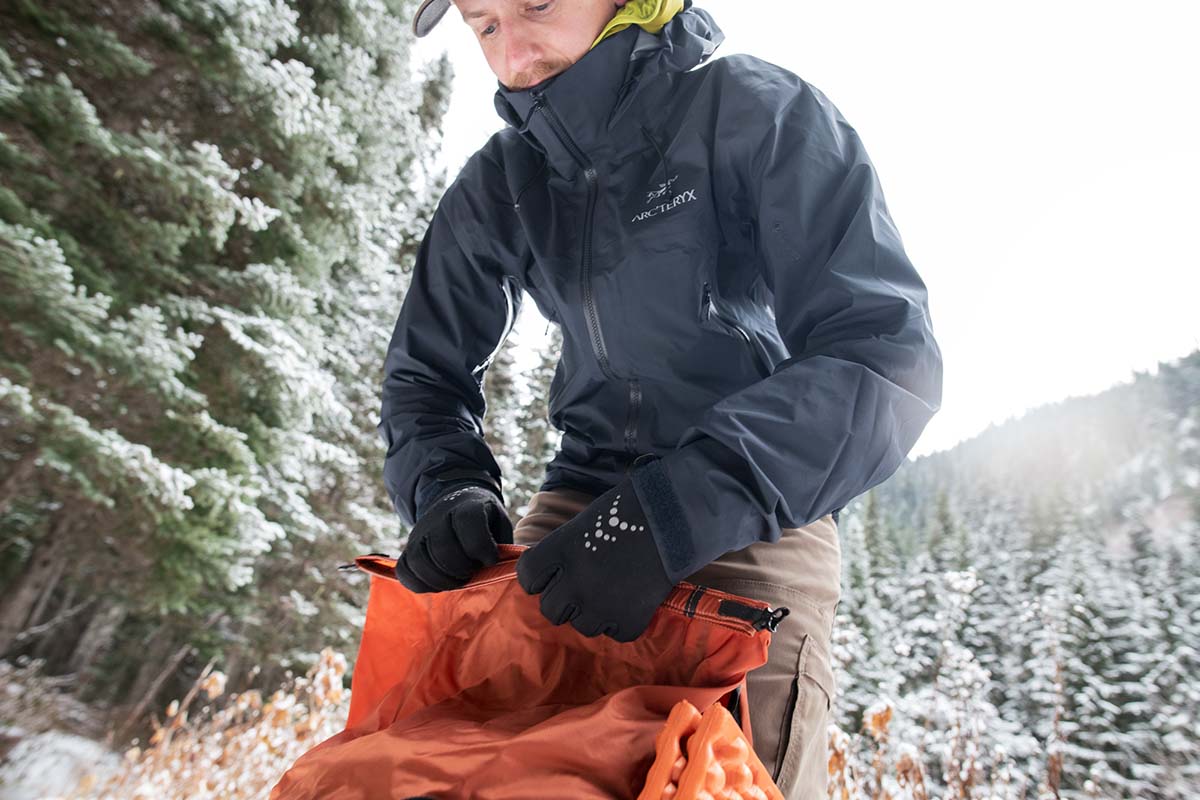
Key Design Features
DropHood
When skiing, mountaineering, or climbing, a sturdy, large, and adjustable hood is a must, and the DropHood on the Beta AR excels at all the above. The design is helmet-compatible and easy to fine tune, with a separate collar for additional comfort and protection. The large hood fit easily around my Smith Level MIPS ski helmet (size medium) without restricting movement. Importantly, the highly adjustable design (there are two cinches at the back and two at the front) means it's not too bulky and cumbersome when only worn over a beanie or hat (a common complaint with helmet-ready hoods). In addition, the laminated brim on the hood effectively kept rain and snow off the face. Finally, I found the drawcord tabs and small buttons at the front easy to reach and large enough to manipulate with ski gloves on, which is extremely handy in cold temperatures when removing gloves means instant discomfort.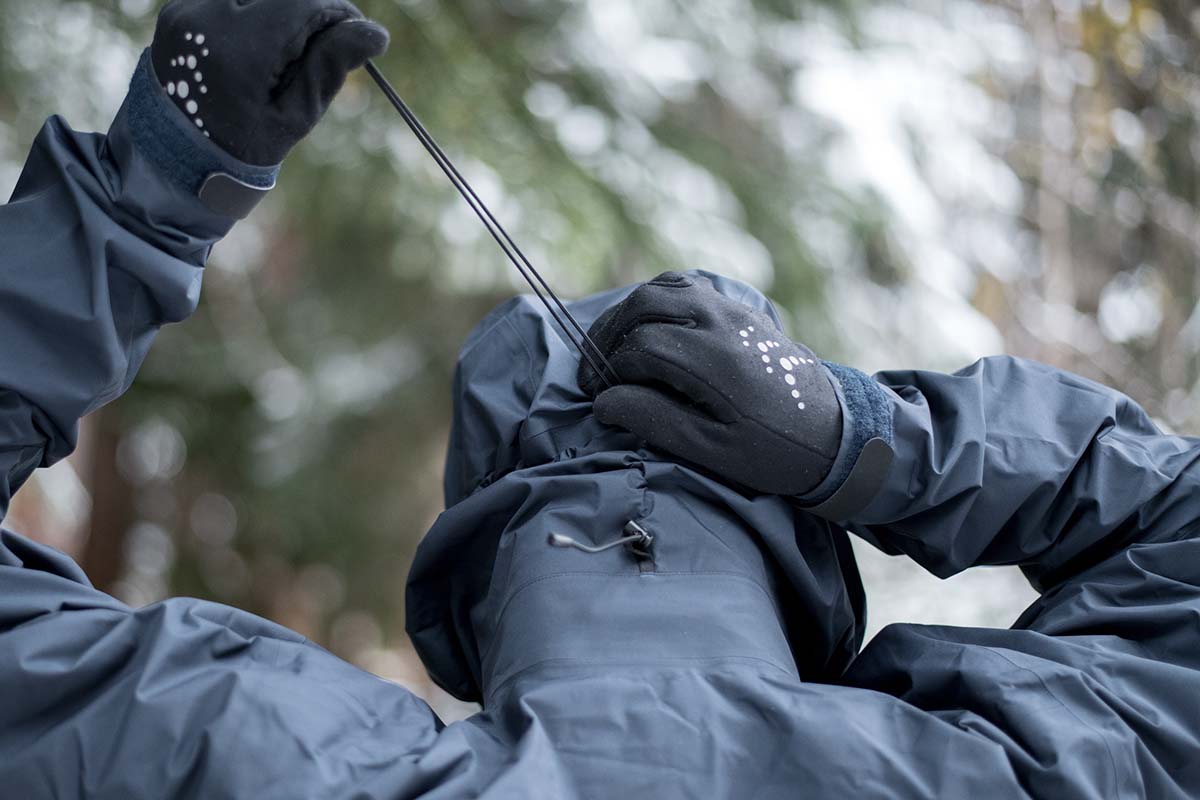
Compared with Arc'teryx's one-piece StormHood, which is found on the brand's Beta SV and Alpha SV jackets, the DropHood is almost identical in size and adjustability. Unfortunately, it does leave a small opening at the front between the collar and hood where blowing snow can potentially build up in a storm (although this requires strong and direct gusts and only happens rarely). That being said, the DropHood's collar is a nice touch when you don't quite need a hood but you still want to tuck your chin away or keep drafts or moisture from entering your jacket (something I found especially useful while hiking). In the end, we prefer the StormHood's slightly improved protection and the weight savings of the one-piece design, but both have their pros and cons.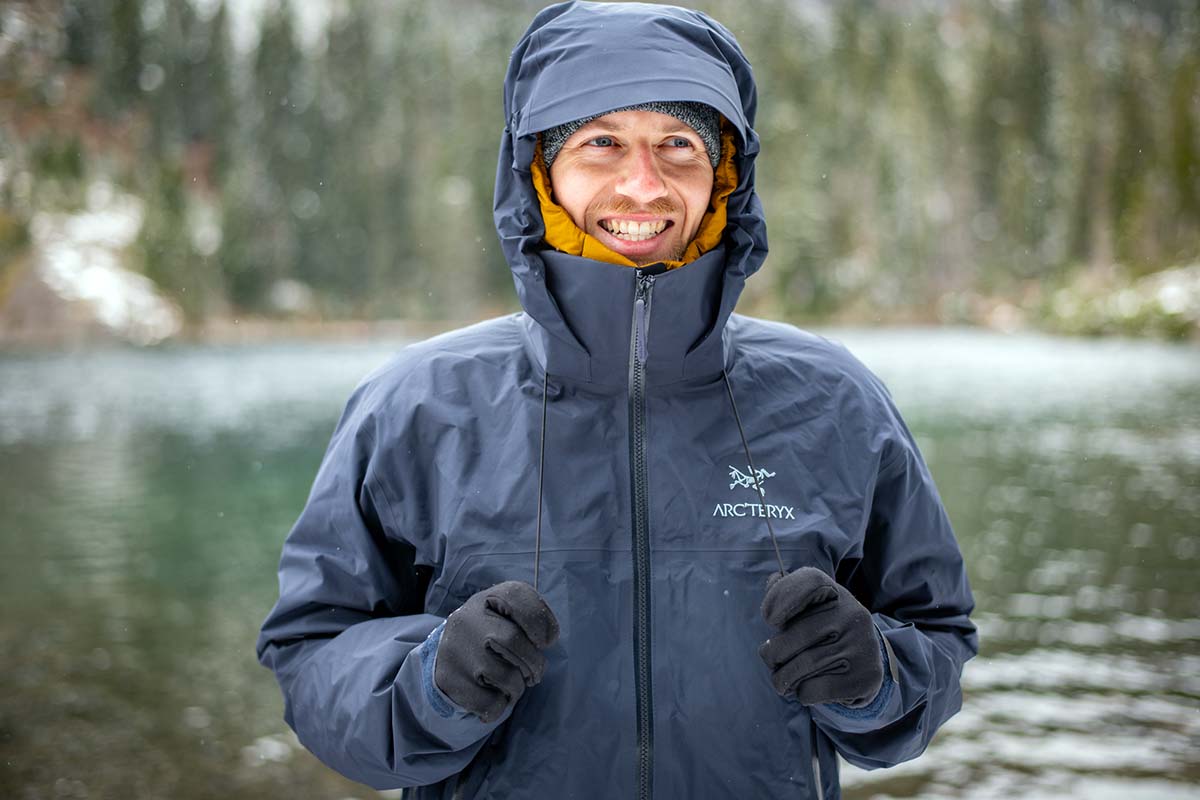
Storage
Storage is another strong suit of the Beta AR and falls nicely in line with its multi-sport intentions. The jacket is outfitted with two large-volume hand pockets that are easily accessible even when wearing a pack or harness. Unlike more streamlined chest pockets, these openings are better placed to protect hands, but can also accommodate larger items like ski goggles, skins, maps, or a two-way radio. A small internal chest pocket is great for stowing smaller items like a mobile phone (it's just large enough to fit my iPhone 11) or GPS device. Skiers may prefer a jacket with drop-in pockets for storing skins closer to the body, but otherwise we think the Beta's organization is spot-on.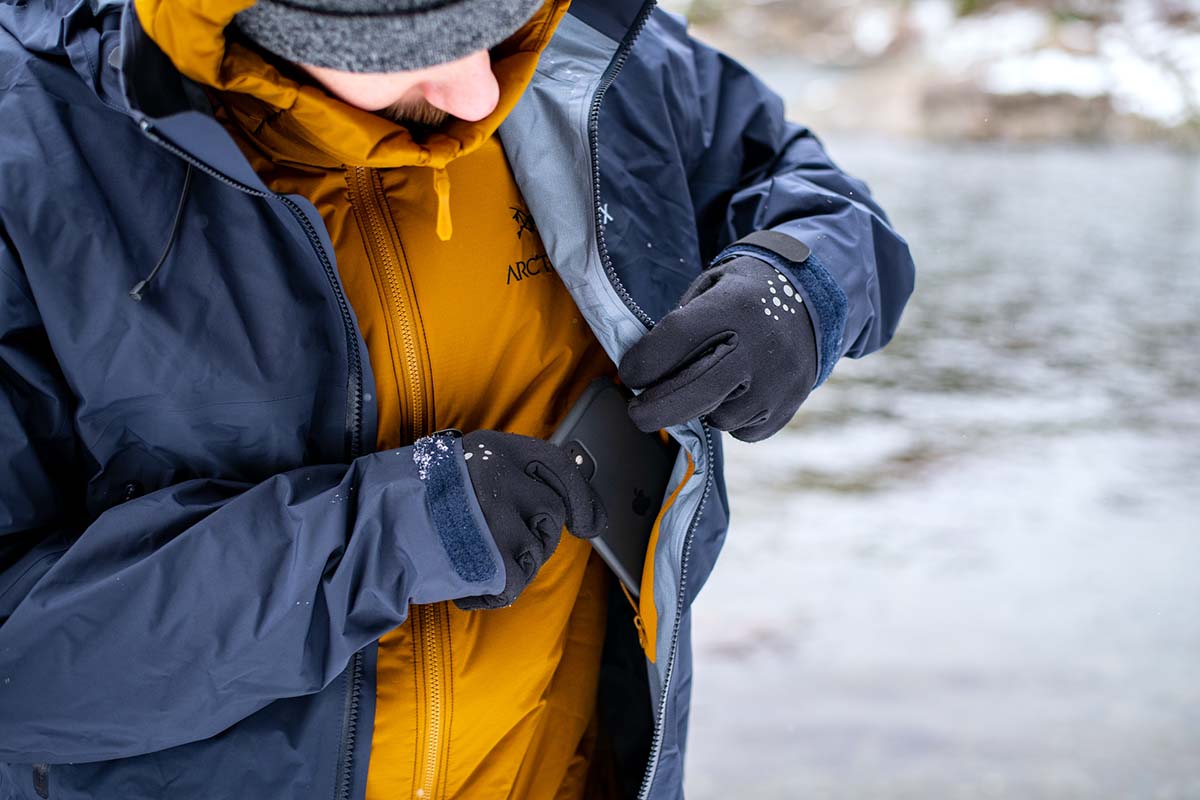
Fit and Sizing
Billed as a "regular fit" by Arc'teryx, I've found the latest Beta AR to fall slightly on the trim end of the spectrum. Wearing a men's medium at 5'9" and 155 pounds, the jacket is a little roomy over just a baselayer, but I didn't have any complaints in terms of mobility or comfort. And there's sufficient space underneath for me to wear a wide range of midlayers, from a lightweight fleece to the brand's Atom AR midweight synthetic. For the Beta's all-rounder intentions, this fit strikes me as just about perfect. And the tailoring is what makes it special: the no-lift gusseted underarms and articulated elbows allowed for an unrestricted feeling when adjusting the hood, reaching for skis in a roof box, and skinning and hiking up sleep slopes.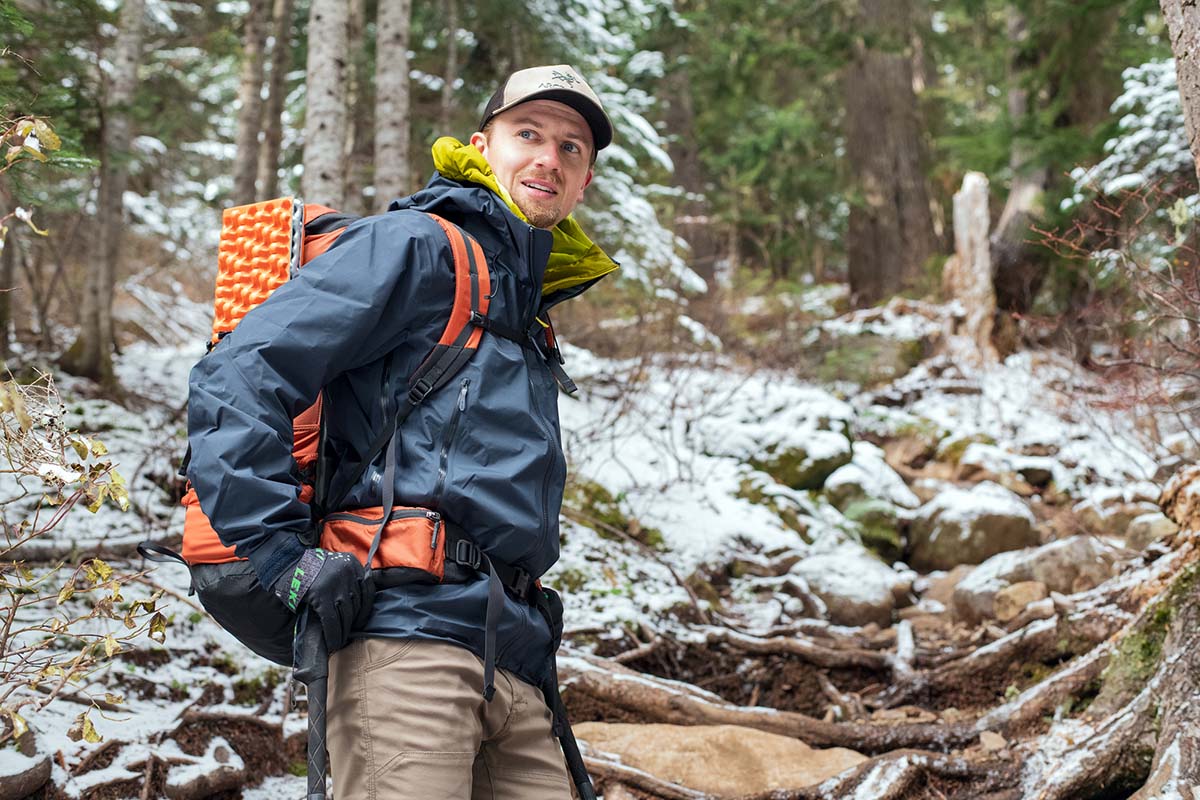
It's important to note that its back length of 30.4 inches (77cm) is slightly on the short end of the spectrum for skiing or wearing consistently under a harness or backpack. Compared to my Sabre AR shell (31 in. back length), the difference is noticeable, although the Beta's drop hem means that it's just long enough to cover my butt when standing upright (and it doesn't ride up too far when bending over to adjust ski boots, reach into a pack, or work on my bindings). Unlike some of Arc'teryx's climbing-oriented jackets, the Beta AR does not feature the harness hemlock, which is a handy feature to keep the jacket from riding up. That said, I haven't found myself needing to pull down on the hem, even when wearing it under hiking and skiing packs.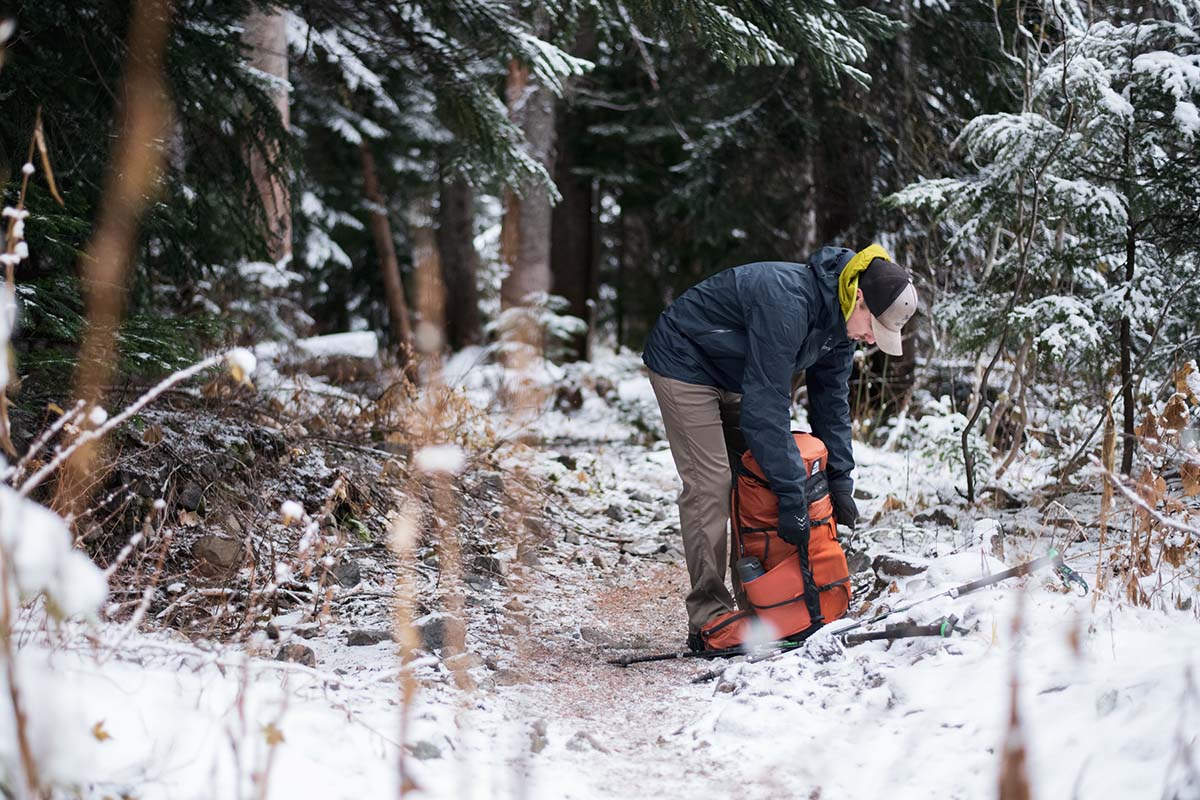
Sustainability
Arc'teryx has made some notable sustainability-related improvements to their lineup recently, which we've been very excited to see. In the case of the Beta AR, the jacket now uses bluesign-approved materials that have been certified as safe for the environment, workers, and consumers. The dark blue Kingfisher colorway has also been dope-dyed—a process that requires less energy and water consumption during production. We hope to see more changes in a future update to the jacket—including the use of recycled materials and a PFC-free DWR coating—but we appreciate the brand's ongoing efforts and transparency.
Other Versions of the Arc'teryx Beta AR
We tested the men's Beta AR Jacket for this review, but the popular line also includes women's-specific shell and pant variations. The women's Beta AR Jacket mirrors the men's design with a Gore-Tex Pro build (also upgraded for 2020-2021), helmet-compatible DropHood, and mix of 40- and 80-denier face fabrics. Its listed weight is a little lighter (14.5 oz.) due to sizing differences with the men's model, but otherwise it's the same high-quality piece. The Beta AR Pant is offered in both men's and women's sizes and is intended for general backcountry use: mountaineering, skiing, backpacking, and ice climbing. Unsurprisingly, it shares a lot in common with the jacket, including the Gore-Tex Pro membrane and regular fit. It's also pretty expensive at $499 but is among the more versatile waterproof pants on the market.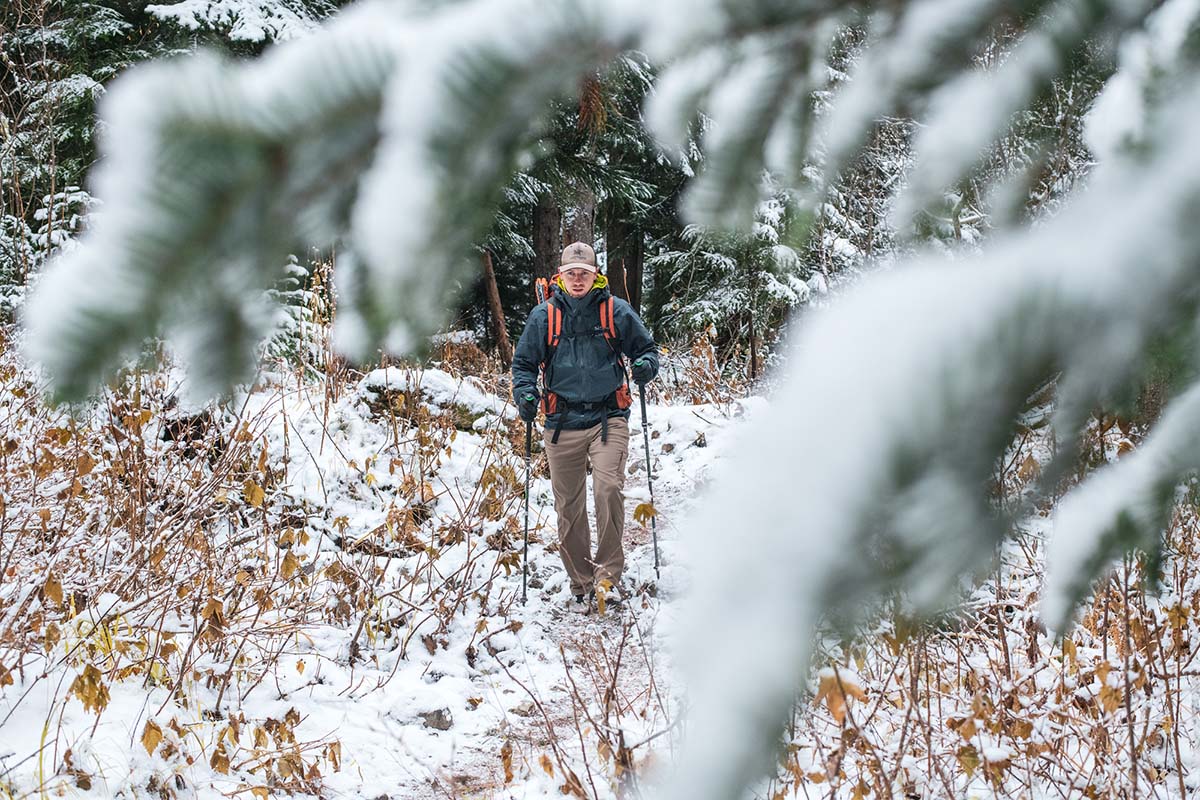
What We Like
- Gore-Tex Pro construction and a mix of 40- and 80-denier shell fabrics make for a bombproof, durable, and reasonably lightweight jacket.
- Large hood does not impair vision and is easy to adjust with gloves on.
- The hand pockets are large enough to fit skins for quick transitions.
- Well-tailored fit provides space to layer without the jacket riding up or restricting movement.
What We Don't
- The separate collar and hood adds weight and allows for snow to occasionally build up in between.
- We'd prefer a longer cut for additional coverage while skiing and wearing under a harness/backpack.
- Breathability has not improved with the latest Gore-Tex Pro "Most Rugged" membrane.
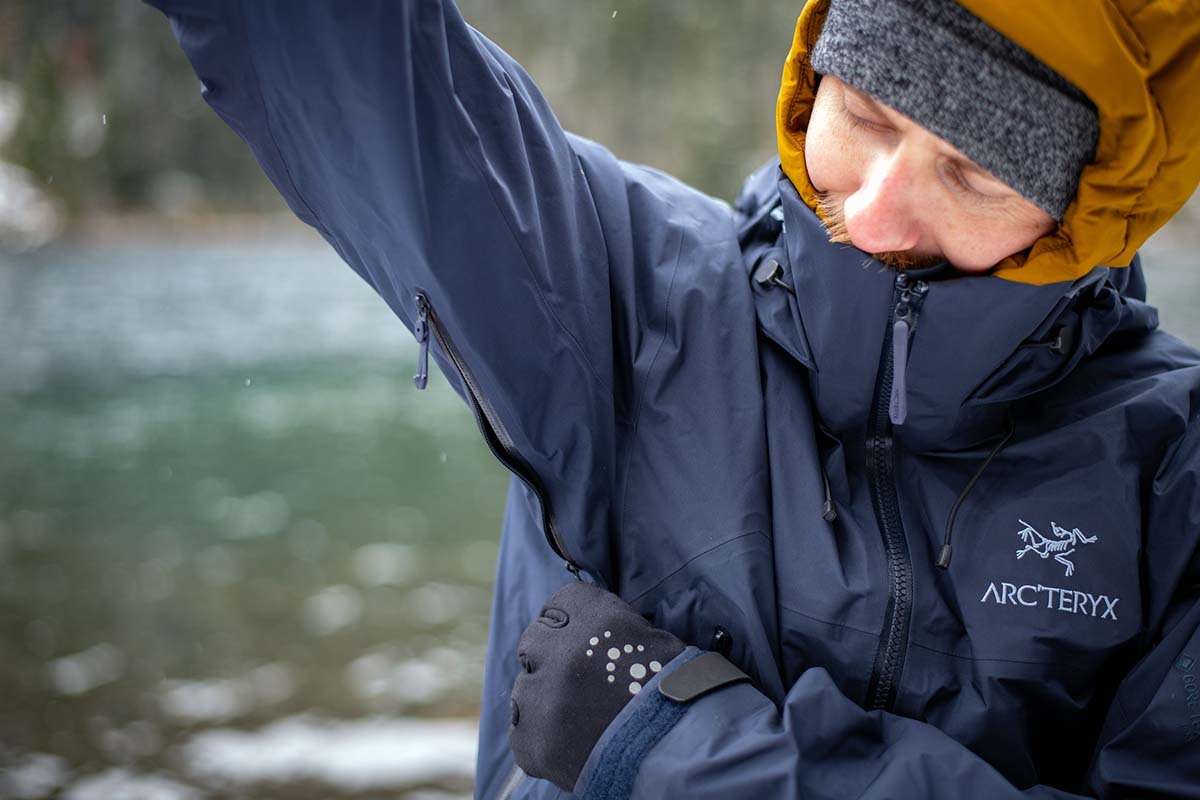
Comparison Table
| Jacket | Price | Weight | Waterproofing | Denier | Pit Zips | Pockets |
|---|---|---|---|---|---|---|
| Arc'teryx Beta AR | $599 | 1 lb. | 3L Gore-Tex Pro | 40D x 80D | Yes | 3 |
| Arc'teryx Alpha SV | $799 | 1 lb. 2 oz. | 3L Gore-Tex Pro | 100D | Yes | 5 |
| Arc'teryx Beta LT | $399 | 13.9 oz. | 3L Gore-Tex | 40D | Yes | 2 |
| Arc'teryx Beta SV | $675 | 1 lb. 1.5 oz. | 3L Gore-Tex Pro | 80D | Yes | 5 |
| Patagonia Pluma | $549 | 14.6 oz. | 3L Gore-Tex Pro | 40D | Yes | 4 |
| MH Exposure/2 GTX Pro Lite | $450 | 14.6 oz. | 3L Gore-Tex Pro | 70D | No | 2 |
The Competition
As the all-rounder of the multi-sport Beta family, the Beta AR is one of our favorite one-quiver hardshell jackets. Arc'teryx has an unmatched selection of storm-ready alpine pieces, so some of the best alternatives to the Beta AR come from in-house. At the premium end is the Alpha SV, which costs an additional $200 than the already-spendy AR. For the extra money, you get greater durability with a very burly 100-denier shell and only a small weight penalty (the Alpha SV clocks in at 1 lb. 2 oz.). It's a climbing-focused piece so there aren't hand pockets included, although the SV's dual chest pockets, sleeve pocket, and internal dump storage are excellent for climbing and skiing purposes. In the end, if you want the best of the best, it's hard to beat the Alpha SV, but it's difficult to justify the price difference unless you'll be out in the absolute worst conditions.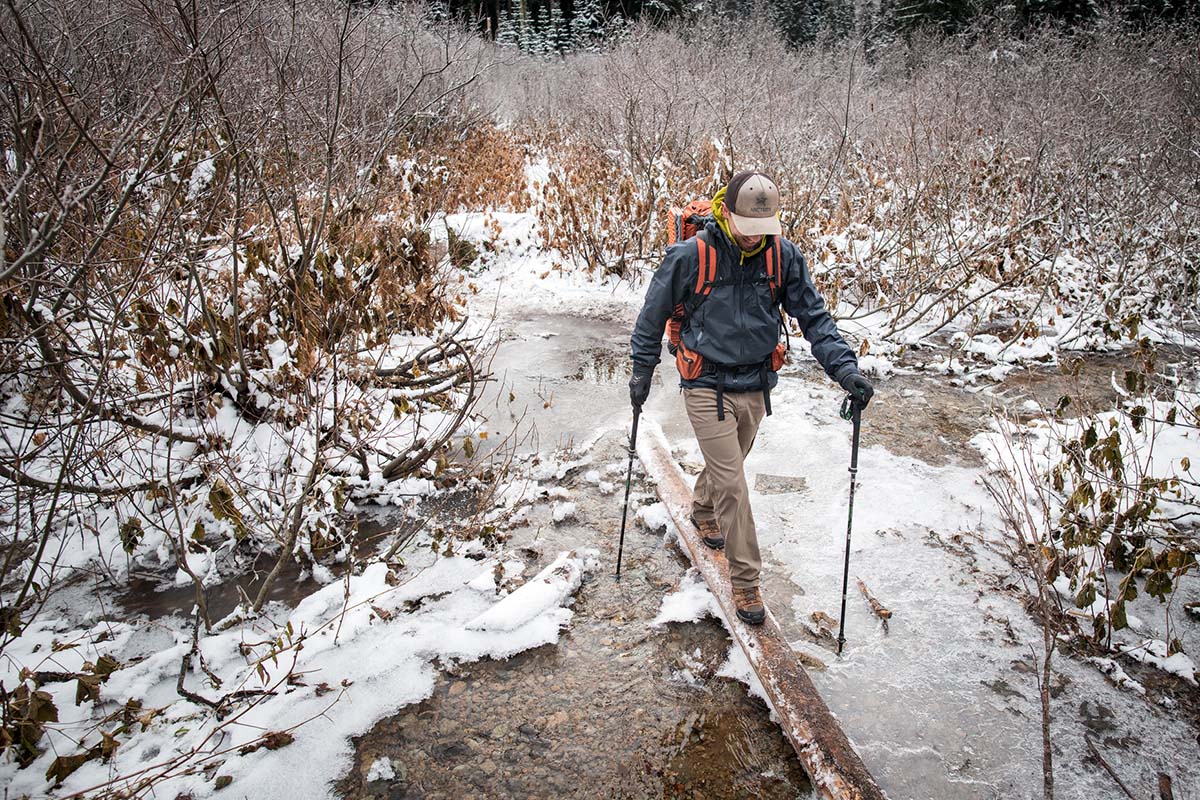
From within the same Beta lineup, two other Gore-Tex-equipped alternatives are the Beta LT ("lightweight") and Beta SV ("severe weather"). The Beta LT saves you a considerable $200 compared to the AR and is lighter by around 2 ounces, but you make some concessions in terms of protection and durability. Most notably, the LT forgoes the "Pro" membrane for a standard 3-layer Gore-Tex construction and lacks the AR's beefed-up 80-denier panels over the hood and shoulders (it uses a 40D fabric throughout). In addition, the LT's StormHood doesn't offer as much above-the-shoulders protection as the AR's DropHood, the trimmer cut makes it harder to layer underneath, and the storage layout is more limited with just two standard hand pockets. All told, the AR is better suited for true performance use, but the LT is a high-quality alternative that still will get the job done on most non-winter backcountry adventures.
Next up is the aforementioned Beta SV, which is the priciest and heaviest option in the Beta collection at a whopping $675 and 1 pound 1.5 ounces. What do you get for the added investment? Namely, the SV is the tougher pick with an 80-denier Gore-Tex Pro construction (also with their Most Rugged Technology). It also provides a little added coverage at the back (31 in. vs. the AR's 30.4-in. length) and sports additional pockets at the outer chest and interior. And like the Beta LT above, the Beta SV utilizes Arc'teryx's StormHood design that's lower-profile, but it lacks the AR's separate collar that provides protection even if you're not wearing the hood (for more information, see our in-depth Beta SV review here). All told, the Beta SV is an undeniably well-equipped piece for truly severe alpine conditions, but the AR is no slouch and remains our favorite overall hardshell for its similar performance at a lower weight and cheaper price.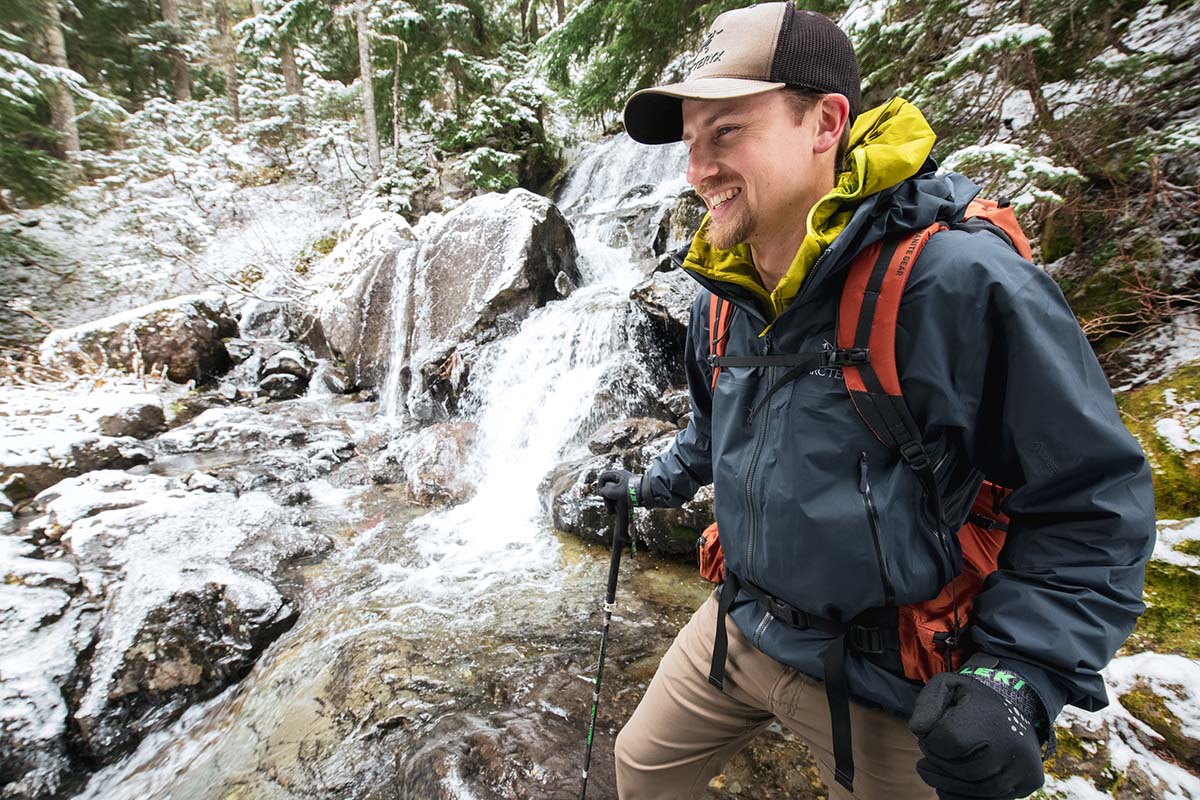
Patagonia offers a quality competitor to the Beta AR in their top-shelf Pluma Jacket. The $549 shell features a 40-denier Gore-Tex Pro construction, pit zips, and a helmet-compatible hood. In testing, the Pluma's hood unfortunately is too small to comfortably fit a ski helmet, and we found the DWR didn't hold up as long as we'd like, but it's a strong competitor overall and undercuts the Beta a little in terms of weight and packability (for more information, read our in-depth Pluma review). As a mountaineering piece, it very well could get the edge for you, but we prefer the more versatile Beta AR for most winter activities.
A final shell to consider is Mountain Hardwear's Exposure/2 GTX Pro Lite. Balancing a 70-denier Gore-Tex Pro construction, $450 price tag, and competitive 14.6-ounce weight, the jacket is a formidable alternative to the Beta AR. In terms of downsides, the Exposure/2 lacks hand pockets and pit zips for dumping heat (the latter of which arguably is a crucial feature for high-output use), and the back length is fairly short at 30 inches (even the Beta AR's 30.4-in. back length felt a bit short for skiing or wearing under a harness or hipbelt). Finally, some might find the multi-toned colorways a bit polarizing, and the Beta AR gets the clear edge in styling with its sleek and streamlined exterior. But from a value perspective, there's no question: the Exposure/2 is one of few winter-ready hardshells at this price point and a sizable step up from the Beta LT ($399) above in terms of all-out protection and durability.
Source: https://www.switchbacktravel.com/reviews/arcteryx-beta-ar
0 Response to "Arcteryx Beta Ar Jacket Mens Medium Blue"
Post a Comment